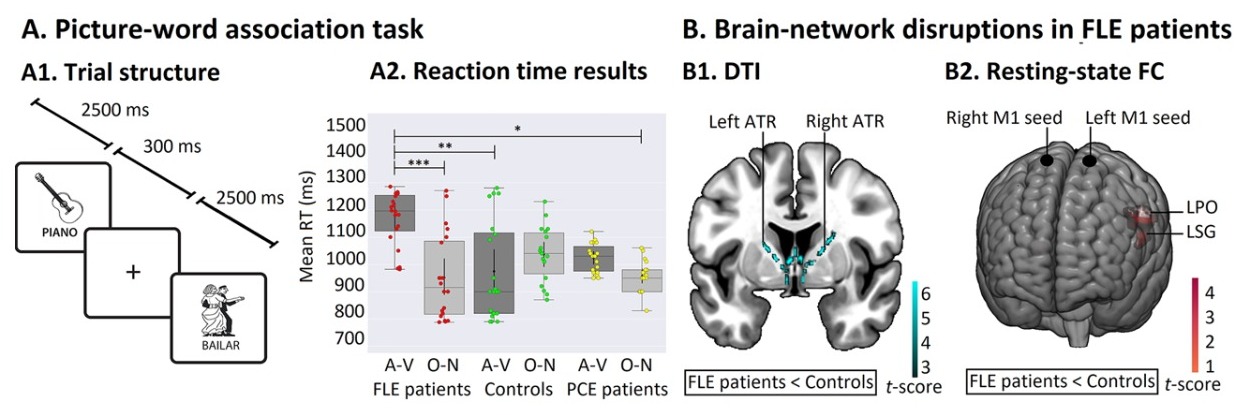Structural and functional motor-network disruptions predict selective action-concept deficits: Evidence from frontal lobe epilepsy
Moguilner, S., Birba, A. Fino, D., Isoardi, R., Huetagoyena, C., Otoya, R., Tirapu, V., Cremaschi, F., Sedeño, L., Ibáñez, A. & García, A. M. (2021). Structural and functional motor-network disruptions predict selective action-concept deficits: Evidence from frontal lobe epilepsy. Cortex 144, 43-45.
En este trabajo, mediante medidas conductuales, tractográficas y de conectividad funcional, mostramos que los pacientes con epilepsia del lóbulo frontal presentan déficits selectivos en el procesamiento de conceptos de acción y que estos pueden predecirse mediante alteraciones estructurales y funcionales en redes motoras. Dichos resultados no se ven replicados en pacientes con epilepsia de la corteza posterior, lo cual refuerza la idea de que los circuitos motores cumplen un papel crítico en dicho dominio semántico.
Para acceder al artículo, hacé click aquí.
Structural and functional motor-network disruptions predict selective action-concept deficits: Evidence from frontal lobe epilepsy
Moguilner, S., Birba, A. Fino, D., Isoardi, R., Huetagoyena, C., Otoya, R., Tirapu, V., Cremaschi, F., Sedeño, L., Ibáñez, A. & García, A. M. (2021). Structural and functional motor-network disruptions predict selective action-concept deficits: Evidence from frontal lobe epilepsy. Cortex 144, 43-45.
Built on neurodegenerative lesions models, the disrupted motor grounding hypothesis (DMGH) posits that motor-system alterations selectively impair action comprehension. However, major doubts remain concerning the dissociability, neural signatures, and etiological generalizability of such deficits. Few studies have compared action-concept outcomes between disorders affecting and sparing motor circuitry, and none has examined their multimodal network predictors via data-driven approaches. Here, we first assessed action- and object-concept processing in patients with frontal lobe epilepsy (FLE), patients with posterior cortex epilepsy (PCE), and healthy controls. Then, we obtained structural and functional network signatures via diffusion tensor imaging and resting-state connectivity measures. Finally, we used these measures to predict behavioral performance with an XGBoost machine learning regression algorithm. Relative to controls, FLE (but not PCE) patients exhibited selective action-concept deficits together with structural and functional abnormalities along motor networks. The XGBoost model reached a significantly large effect size only for action-concept outcomes in FLE, mainly predicted by structural (cortico-spinal tract, anterior thalamic radiation, uncinate fasciculus) and functional (M1-parietal/supramarginal connectivity) motor networks. These results extend the DMGH, suggesting that action-concept deficits are dissociable markers of frontal/motor (relative to posterior) disruptions, directly related to the structural and functional integrity of motor networks, and traceable beyond canonical movement disorders.
To access the full paper, click here.



